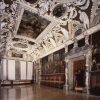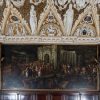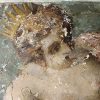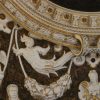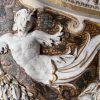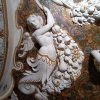Room of the Four Doors – Conservation plan
The current conservation treatment consists of phases I and II that are a part of a series of major interventions that will focus on the decorative aspects of the room over the next several years. These first two phases will focus on the vaulted ceiling with stuccos and frescoes and the four stone portals surmounted by sculptures and monochrome painted canvases.
The structural integrity of the ceiling vault will be verified to determine if any repairs or additional reinforcements are needed. The precarious state of conservation of the paintings, stucco, and stone will be addressed through the consolidation, cleaning, and integration of these artworks using only materials and techniques that not only respect and preserve the original decoration, but that are fully reversible in the future. To further restore the integrity and legibility of the artworks, any inappropriate or detrimental non-original surface layers that were applied during numerous previous interventions will be revised or replaced, such as oxidized varnishes, altered repainting, and surface protectants.
During your visit to the Doge’s Palace, you can observe the treatment underway on a selection of canvas paintings from this room in a special laboratory area just outside of the Sala del Maggior Consiglio.
![]()
The Room of the Four Doors
The Room of the Four Doors is one of the most remarkable public spaces in the Doge’s Palace. A large rectangular hall, the Sala delle Quattro Porte serves as a passageway into the meeting rooms of Venice’s most powerful political bodies: the Senate, the Collegio, and the Council of Ten. Influential patricians, foreign diplomats, and royal guests passed through the Room of the Four Doors to reach their offices and meet government officials.
Following a devastating fire that destroyed part of the Doge’s Palace on May 11, 1574, a campaign to rebuild and redecorate the room was immediately launched involving the most important artists of the era. The head architect of the Venetian Republic (proto) Antonio da Ponte directed the work, and architect Andrea Palladio contributed to the project plans.
Between 1575 and 1576, Giovanni Battista Cambi, called “il Bombarda,” carved the ceiling’s stucco moldings and mythological sculptures. Nearly a year later, the vault was enriched with intricate grotesque decorations.
From 1576–1577, Jacopo Tintoretto frescoed the ceiling and the lunettes with allegorical scenes. The iconographic program of the frescoes was devised by humanist Francesco Sansovino to glorify Venice’s mythical birth, independence, power, and virtues. Due to condition issues, many of the frescoes were restored and repainted by Nicolò Bambini 1713.

VIRTUAL TOUR >>>
![]()
Conservation project funded thanks to the contribution of SAVE VENICE >
Partly financed with Art Bonus
